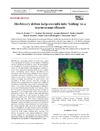Identificador persistente para citar o vincular este elemento:
https://accedacris.ulpgc.es/jspui/handle/10553/49561
| Campo DC | Valor | idioma |
|---|---|---|
| dc.contributor.author | Franco, João N. | en_US |
| dc.contributor.author | Wernberg, Thomas | en_US |
| dc.contributor.author | Bertocci, Iacopo | en_US |
| dc.contributor.author | Duarte, Pedro | en_US |
| dc.contributor.author | Jacinto, David | en_US |
| dc.contributor.author | Vasco-Rodrigues, Nuno | en_US |
| dc.contributor.author | Tuya, Fernando | en_US |
| dc.date.accessioned | 2018-11-24T08:50:18Z | - |
| dc.date.available | 2018-11-24T08:50:18Z | - |
| dc.date.issued | 2015 | en_US |
| dc.identifier.issn | 0171-8630 | en_US |
| dc.identifier.uri | https://accedacris.ulpgc.es/handle/10553/49561 | - |
| dc.description.abstract | Assessing effects of herbivory across broad gradients of varying ocean climate conditions and over small spatial scales is crucial for understanding its influence on primary producers. Effects of herbivory on the distribution and abundance of kelp recruits were examined experimentally at two regions under contrasting ocean climate. Specifically, the abundance and survivorship of kelp recruits and the abundance of macro-herbivores were compared between a ‘cool’ and a ‘warm’ region in northern and central Portugal, respectively. In each region, the abundance of kelp recruits and the intensity of grazing were compared between habitats of different topography within reefs (open reef vs. crevices). Compared to the ‘warm’ region, the abundance of kelp recruits was 3.9 times greater in the ‘cool’ region, where 85% of recruits were found in open reef habitats. In contrast, 87% of recruits in the ‘warm’ region were restricted to crevices. The ‘warm’ region had 140 times greater abundances of sea urchins, 45 times more herbivorous fish and 4.1 times more grazing marks on kelp recruits than the ‘cool’ region. Grazing assays showed ca. 50 times higher rates of kelp biomass consumption, mainly by fishes, and zero survivorship of kelp recruits in the ‘warm’ relative to the ‘cool’ region. This study suggests both temperature and herbivores affect abundances of kelp recruits across latitudes, and demonstrates how herbivores affect their distribution at local scales, driving kelp recruits into ‘hiding’ in crevices under intense herbivory. Consequently, where net recruitment success is compromised by herbivory, the persistence of kelps will be contingent on availability of topographical refuges. | en_US |
| dc.language | eng | en_US |
| dc.publisher | 0171-8630 | - |
| dc.relation.ispartof | Marine Ecology - Progress Series | en_US |
| dc.source | Marine Ecology Progress Series [ISSN 0171-8630], v. 536, p. 1-9 | en_US |
| dc.subject | 241705 Biología marina | en_US |
| dc.subject.other | Atlantic Ocean | en_US |
| dc.subject.other | Portugal | en_US |
| dc.subject.other | Habitat complexity | en_US |
| dc.subject.other | Climate | en_US |
| dc.subject.other | Kelp forests | en_US |
| dc.subject.other | Grazing | en_US |
| dc.subject.other | Range limit | en_US |
| dc.title | Herbivory drives kelp recruits into 'hiding' in a warm ocean climate | en_US |
| dc.type | info:eu-repo/semantics/Article | en_US |
| dc.type | Article | en_US |
| dc.identifier.doi | 10.3354/meps11445 | en_US |
| dc.identifier.scopus | 84943189619 | - |
| dc.identifier.isi | 000363732500001 | - |
| dc.contributor.authorscopusid | 36903257100 | - |
| dc.contributor.authorscopusid | 8657683700 | - |
| dc.contributor.authorscopusid | 6506249589 | - |
| dc.contributor.authorscopusid | 57212567230 | - |
| dc.contributor.authorscopusid | 7005201821 | - |
| dc.contributor.authorscopusid | 25225819400 | - |
| dc.contributor.authorscopusid | 56888833000 | - |
| dc.contributor.authorscopusid | 6603608107 | - |
| dc.description.lastpage | 9 | en_US |
| dc.description.firstpage | 1 | en_US |
| dc.relation.volume | 536 | en_US |
| dc.investigacion | Ciencias | en_US |
| dc.type2 | Artículo | en_US |
| dc.contributor.daisngid | 2348615 | - |
| dc.contributor.daisngid | 272528 | - |
| dc.contributor.daisngid | 729735 | - |
| dc.contributor.daisngid | 346996 | - |
| dc.contributor.daisngid | 2319821 | - |
| dc.contributor.daisngid | 7945501 | - |
| dc.contributor.daisngid | 308553 | - |
| dc.utils.revision | Sí | en_US |
| dc.contributor.wosstandard | WOS:Franco, JN | - |
| dc.contributor.wosstandard | WOS:Wernberg, T | - |
| dc.contributor.wosstandard | WOS:Bertocci, I | - |
| dc.contributor.wosstandard | WOS:Duarte, P | - |
| dc.contributor.wosstandard | WOS:Jacinto, D | - |
| dc.contributor.wosstandard | WOS:Vasco-Rodrigues, N | - |
| dc.contributor.wosstandard | WOS:Tuya, F | - |
| dc.date.coverdate | Septiembre 2015 | en_US |
| dc.identifier.ulpgc | Sí | es |
| dc.description.sjr | 1,552 | |
| dc.description.jcr | 2,361 | |
| dc.description.sjrq | Q1 | |
| dc.description.jcrq | Q1 | |
| dc.description.scie | SCIE | |
| item.grantfulltext | open | - |
| item.fulltext | Con texto completo | - |
| crisitem.author.dept | GIR ECOAQUA: Biodiversidad y Conservación | - |
| crisitem.author.dept | IU de Investigación en Acuicultura Sostenible y Ec | - |
| crisitem.author.dept | Departamento de Biología | - |
| crisitem.author.orcid | 0000-0001-8316-5887 | - |
| crisitem.author.parentorg | IU de Investigación en Acuicultura Sostenible y Ec | - |
| crisitem.author.fullName | Tuya Cortés, Fernando José | - |
| Colección: | Artículos | |
Citas SCOPUSTM
53
actualizado el 08-jun-2025
Citas de WEB OF SCIENCETM
Citations
52
actualizado el 08-jun-2025
Visitas
119
actualizado el 31-ago-2024
Descargas
109
actualizado el 31-ago-2024
Google ScholarTM
Verifica
Altmetric
Comparte
Exporta metadatos
Los elementos en ULPGC accedaCRIS están protegidos por derechos de autor con todos los derechos reservados, a menos que se indique lo contrario.
